steering Alfa Romeo 8C 2007 Owner handbook (in English)
[x] Cancel search | Manufacturer: ALFA ROMEO, Model Year: 2007, Model line: 8C, Model: Alfa Romeo 8C 2007Pages: 223, PDF Size: 14.35 MB
Page 132 of 223
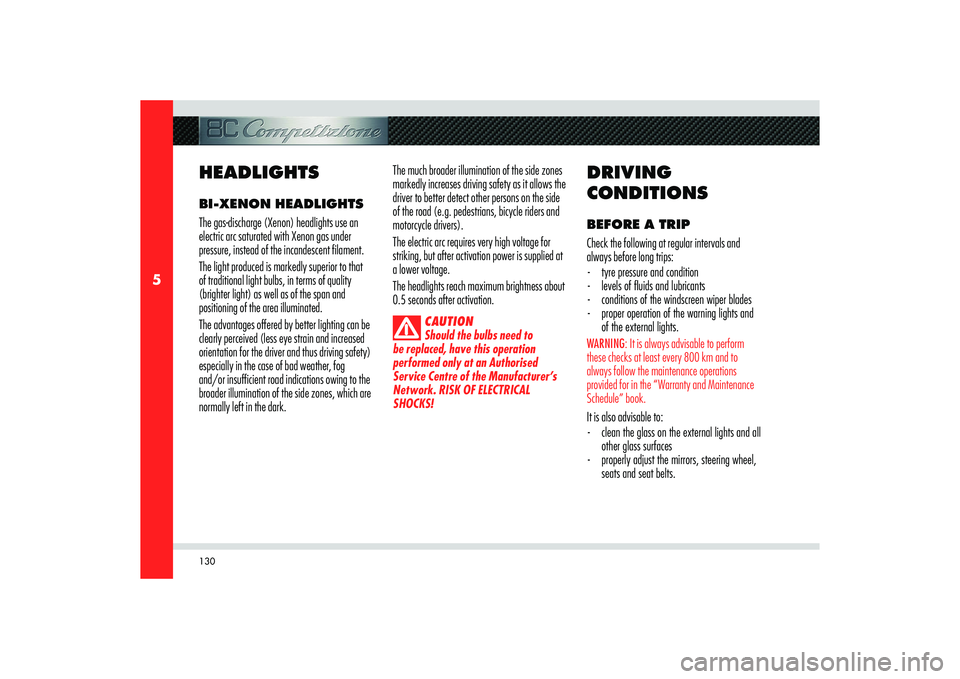
130
5
HEADLIGHTSBI-XENON HEADLIGHTS
The gas-discharge (Xenon) headlights use an
electric arc saturated with Xenon gas under
pressure, instead of the incandescent filament.
The light produced is markedly superior to that
of traditional light bulbs, in terms of quality
(brighter light) as well as of the span and
positioning of the area illuminated.
The advantages offered by better lighting can be
clearly perceived (less eye strain and increased
orientation for the driver and thus driving safety)
especially in the case of bad weather, fog
and/or insufficient road indications owing to the
broader illumination of the side zones, which are
normally left in the dark.The much broader illumination of the side zones
markedly increases driving safety as it allows the
driver to better detect other persons on the side
of the road (e.g. pedestrians, bicycle riders and
motorcycle drivers).
The electric arc requires very high voltage for
striking, but after activation power is supplied at
a lower voltage.
The headlights reach maximum brightness about
0.5 seconds after activation.
CAUTION
Should the bulbs need to
be replaced, have this operation
performed only at an Authorised
Service Centre of the Manufacturer’s
Network. RISK OF ELECTRICAL
SHOCKS!
DRIVING
CONDITIONSBEFORE A TRIP
Check the following at regular intervals and
always before long trips:
- tyre pressure and condition
- levels of fl uids and lubricants
- conditions of the windscreen wiper blades
- proper operation of the warning lights and
of the external lights.WARNING: It is always advisable to perform
these checks at least every 800 km and to
always follow the maintenance operations
provided for in the “Warranty and Maintenance
Schedule” book.It is also advisable to:
- clean the glass on the external lights and all
other glass surfaces
- properly adjust the mirrors, steering wheel,
seats and seat belts.
Page 133 of 223
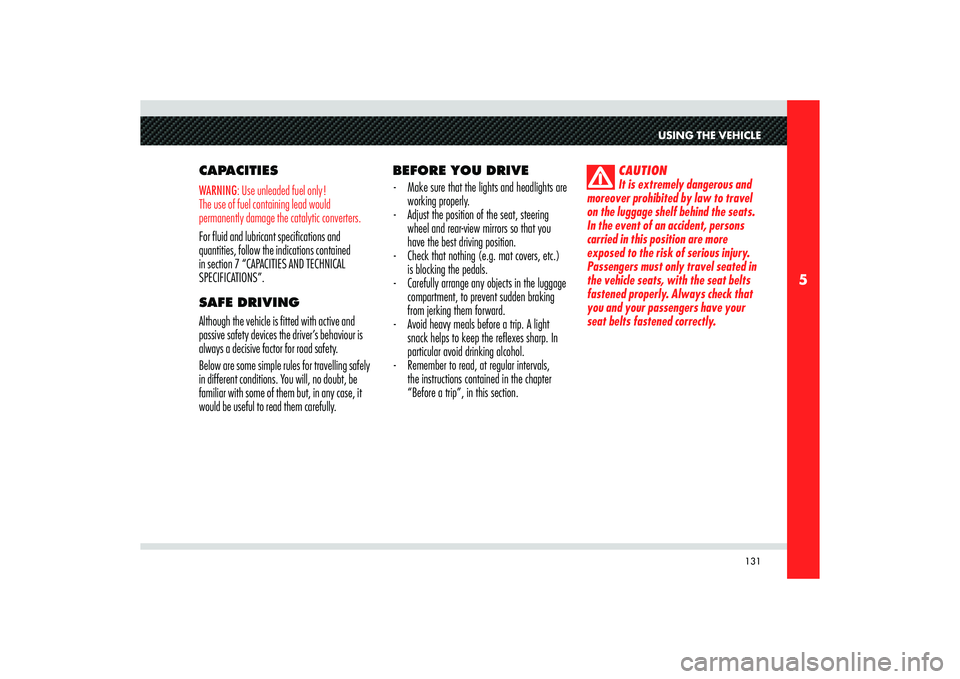
131
5
USING THE VEHICLE
CAPACITIESWARNING: Use unleaded fuel only!
The use of fuel containing lead would
permanently damage the catalytic converters.For fluid and lubricant specifications and
quantities, follow the indications contained
in section 7 “CAPACITIES AND TECHNICAL
SPECIFICATIONS”.
SAFE DRIVING
Although the vehicle is fitted with active and
passive safety devices the driver’s behaviour is
always a decisive factor for road safety.
Below are some simple rules for travelling safely
in different conditions. You will, no doubt, be
familiar with some of them but, in any case, it
would be useful to read them carefully.BEFORE YOU DRIVE
- Make sure that the lights and headlights are
working properly.
- Adjust the position of the seat, steering
wheel and rear-view mirrors so that you
have the best driving position.
- Check that nothing (e.g. mat covers, etc.)
is blocking the pedals.
- Carefully arrange any objects in the luggage
compartment, to prevent sudden braking
from jerking them forward.
- Avoid heavy meals before a trip. A light
snack helps to keep the refl exes sharp. In
particular avoid drinking alcohol.
- Remember to read, at regular intervals,
the instructions contained in the chapter
“Before a trip”, in this section.
CAUTION
It is extremely dangerous and
moreover prohibited by law to travel
on the luggage shelf behind the seats.
In the event of an accident, persons
carried in this position are more
exposed to the risk of serious injury.
Passengers must only travel seated in
the vehicle seats, with the seat belts
fastened properly. Always check that
you and your passengers have your
seat belts fastened correctly.
Page 159 of 223
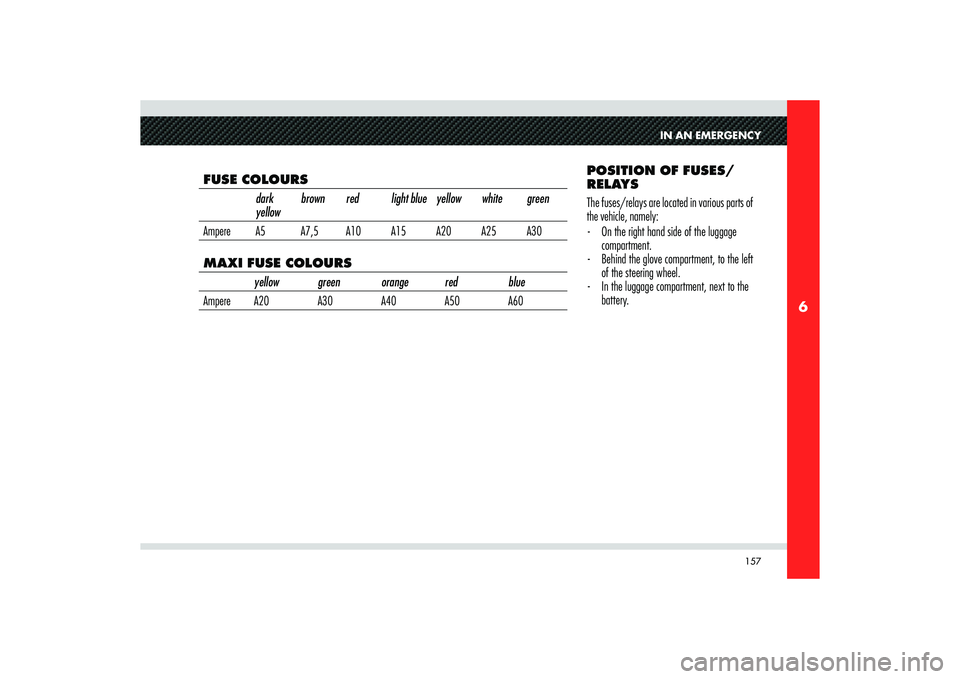
157
6
IN AN EMERGENCY
POSITION OF FUSES/
RELAYS
The fuses/relays are located in various parts of
the vehicle, namely:
- On the right hand side of the luggage
compartment.
- Behind the glove compartment, to the left
of the steering wheel.
- In the luggage compartment, next to the
battery.
FUSE COLOURS
dark
yellowbrown red light blue yellow white green
Ampere A5 A7,5 A10 A15 A20 A25 A30MAXI FUSE COLOURS
yellow green orange red blue
Ampere A20 A30 A40 A50 A60
Page 164 of 223
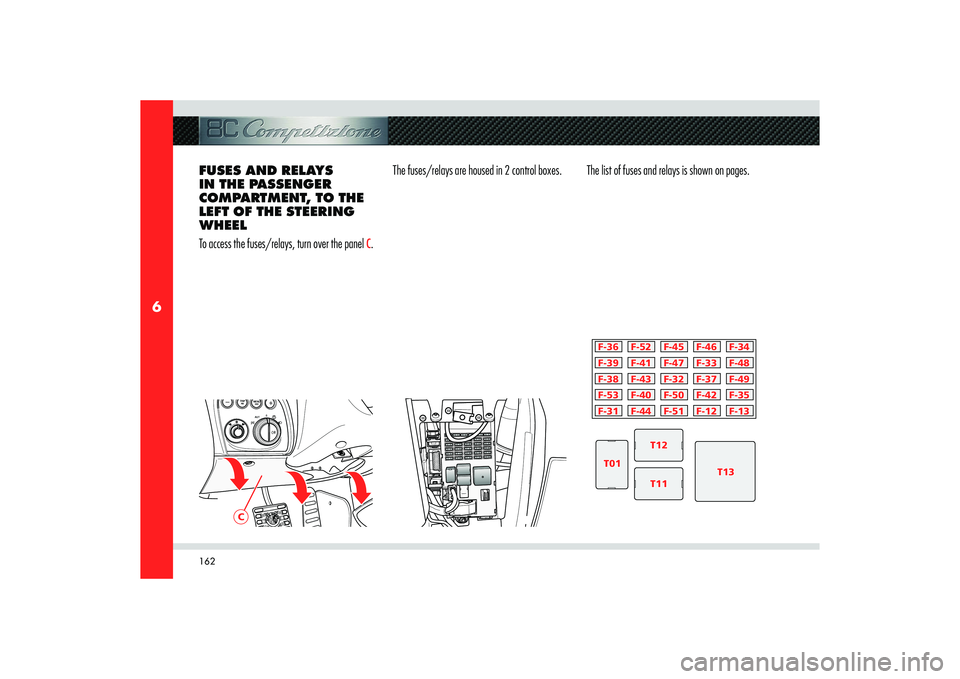
162
6
C
F-36
F-39
F-38
F-53
F-31F-52
F-41
F-43
F-40
F-44F-45
F-47
F-32
F-50
F-51F-46
F-33
F-37
F-42
F-12F-34
F-48
F-49
F-35
F-13
T01T12
T11T13
FUSES AND RELAYS
IN THE PASSENGER
COMPARTMENT, TO THE
LEFT OF THE STEERING
WHEEL
To access the fuses/relays, turn over the panel
C.The fuses/relays are housed in 2 control boxes. The list of fuses and relays is shown on pages.
Page 165 of 223
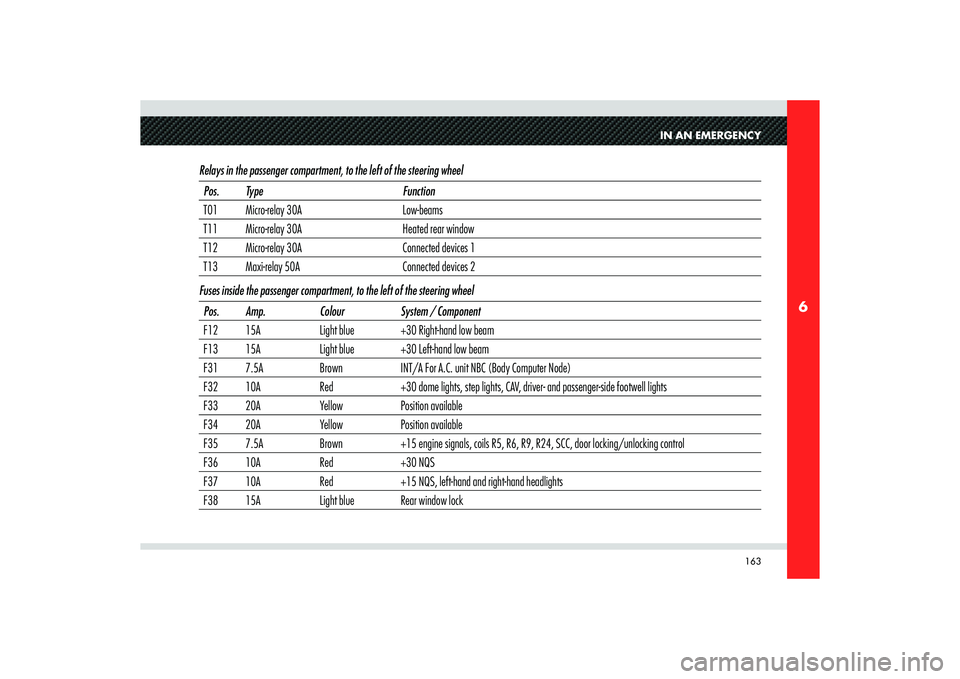
163
6
IN AN EMERGENCY
Relays in the passenger compartment, to the left of the steering wheelPos. Type Function
T01 Micro-relay 30A Low-beams
T11 Micro-relay 30A Heated rear window
T12 Micro-relay 30A Connected devices 1
T13 Maxi-relay 50A Connected devices 2
Fuses inside the passenger compartment, to the left of the steering wheel
Pos. Amp. Colour System / Component
F12 15A Light blue +30 Right-hand low beam
F13 15A Light blue +30 Left-hand low beam
F31 7.5A Brown INT/A For A.C. unit NBC (Body Computer Node)
F32 10A Red +30 dome lights, step lights, CAV, driver- and passenger-side footwell lights
F33 20A Yellow Position available
F34 20A Yellow Position available
F35 7.5A Brown +15 engine signals, coils R5, R6, R9, R24, SCC, door locking/unlocking control
F36 10A Red +30 NQS
F37 10A Red +15 NQS, left-hand and right-hand headlights
F38 15A Light blue Rear window lock
Page 172 of 223

170
6
IF YOU HAVE TO
TOW THE VEHICLE If you need to tow the vehicle, observe the
following recommendations:
- if possible, have the vehicle transported on
a vehicle equipped with loading platform
and specifi c for roadside assistance and
recovery.
If this is not possible:
- Tow the vehicle for a stretch of less than
100 km at a speed below 60 km/h, using
the towing hook provided in the toolkit.To be able to tow the vehicle, you must:
- Turn the ignition key to MAR without
starting the engine (see page 87)
- Engage neutral (position N) by
simultaneously pulling the gearshift paddles
UP and DOWN while holding the brake
pedal depressed (see page 118)
- turn the key back to position STOP.
CAUTION
Do not extract the key, as the
steering wheel will lock automatically
and you will be unable to steer the
wheels.
CAUTION
When towing the vehicle, make
sure that you observe the road traffic
regulations concerning both the towing
device and driving conduct.CAUTION
When towing the vehicle with
the engine off, remember that, without
the assistance of the brake servo, a
stronger effort is required on the brake
pedal for braking and on the steering
wheel for steering.
CAUTION
Screw down the towing hook
into its seat (approx. 11 turns).
Accurately clean the threaded seat
before tightening the hook.
WARNING: If you have to tow the vehicle with 2
wheels raised, ensure that the ignition key is in
the STOP position. Otherwise, when the VDC is
active, the relative ECU will store a malfunction,
which will cause the illumination of the warning
light
on the instrument panel display. This
requires the intervention of an Authorised
Service Centre of the Manufacturer’s Network
to correct the system malfunction.
Page 180 of 223
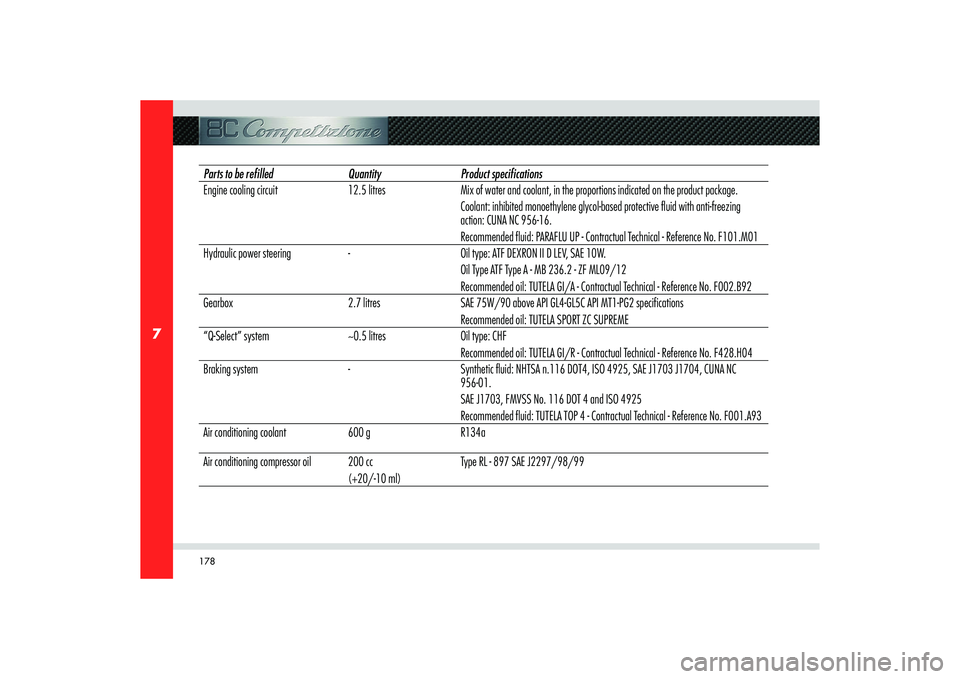
178
7
Parts to be refi lled Quantity Product specifi cations
Engine cooling circuit 12.5 litres Mix of water and coolant, in the proportions indicated on the product package.
Coolant: inhibited monoethylene glycol-based protective fluid with anti-freezing
action: CUNA NC 956-16.
Recommended fluid: PARAFLU UP - Contractual Technical - Reference No. F101.M01
Hydraulic power steering - Oil type: ATF DEXRON II D LEV, SAE 10W.
Oil Type ATF Type A - MB 236.2 - ZF ML09/12
Recommended oil: TUTELA GI/A - Contractual Technical - Reference No. F002.B92
Gearbox 2.7 litres SAE 75W/90 above API GL4-GL5C API MT1-PG2 specifications
Recommended oil: TUTELA SPORT ZC SUPREME
“Q-Select” system ~0.5 litres Oil type: CHF
Recommended oil: TUTELA GI/R - Contractual Technical - Reference No. F428.H04
Braking system - Synthetic fluid: NHTSA n.116 DOT4, ISO 4925, SAE J1703 J1704, CUNA NC
956-01.
SAE J1703, FMVSS No. 116 DOT 4 and ISO 4925
Recommended fluid: TUTELA TOP 4 - Contractual Technical - Reference No. F001.A93
Air conditioning coolant 600 g R134a
Air conditioning compressor oil 200 cc
(+20/-10 ml)Type RL - 897 SAE J2297/98/99
Page 185 of 223
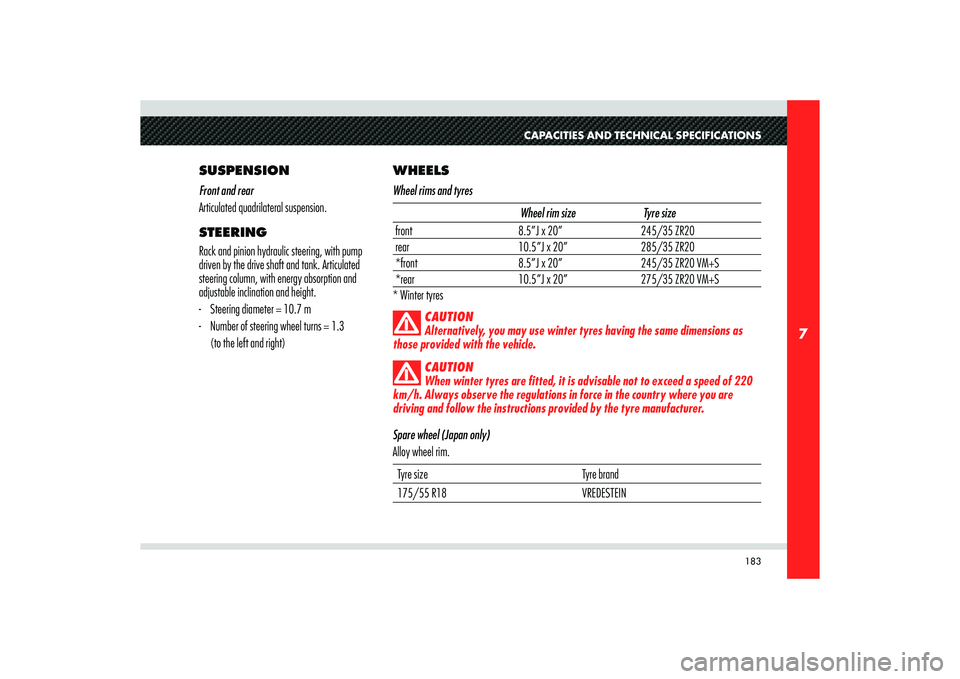
183
7
CAPACITIES AND TECHNICAL SPECIFICATIONS
SUSPENSION
Front and rear
Articulated quadrilateral suspension.
STEERING
Rack and pinion hydraulic steering, with pump
driven by the drive shaft and tank. Articulated
steering column, with energy absorption and
adjustable inclination and height.
- Steering diameter = 10.7 m
- Number of steering wheel turns = 1.3
(to the left and right)WHEELS
Wheel rims and tyres
Wheel rim size Tyre size
front 8.5”J x 20” 245/35 ZR20
rear 10.5”J x 20” 285/35 ZR20
*front 8.5”J x 20” 245/35 ZR20 VM+S
*rear 10.5”J x 20” 275/35 ZR20 VM+S
* Winter tyres
CAUTION
Alternatively, you may use winter tyres having the same dimensions as
those provided with the vehicle.
CAUTION
When winter tyres are fitted, it is advisable not to exceed a speed of 220
km/h. Always observe the regulations in force in the country where you are
driving and follow the instructions provided by the tyre manufacturer.
Spare wheel (Japan only)
Alloy wheel rim.Tyre size Tyre brand
175/55 R18 VREDESTEIN
Page 195 of 223
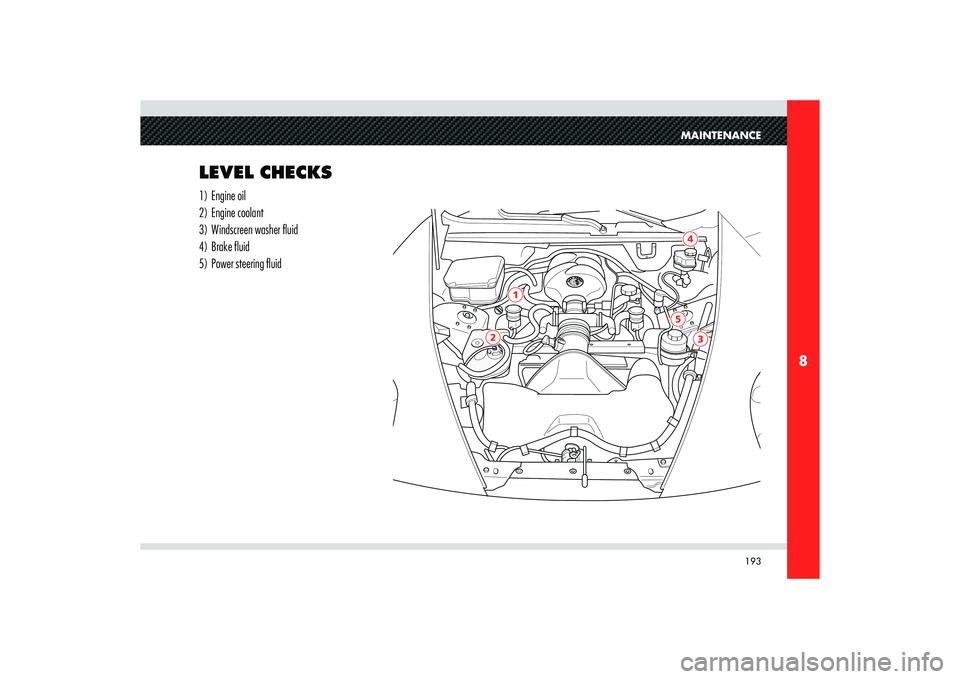
193
8
2
5
3
1
4MAINTENANCE
LEVEL CHECKS1) Engine oil
2) Engine coolant
3) Windscreen washer fluid
4) Brake fluid
5) Power steering fluid
Page 198 of 223
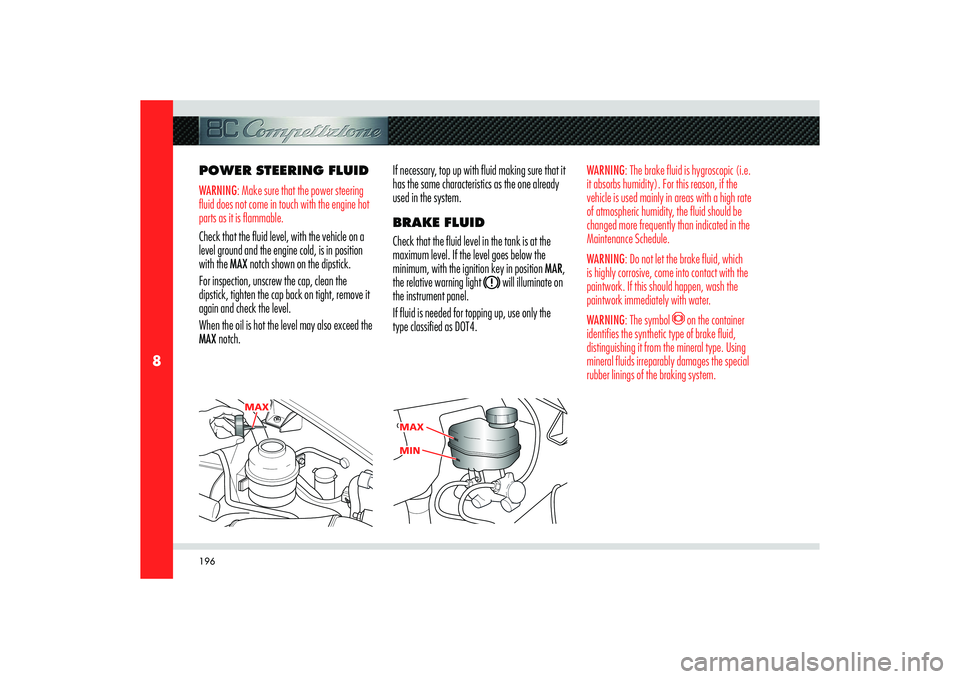
196
8
MAX
MA
X MAX
MIN MIN
POWER STEERING FLUIDWARNING: Make sure that the power steering
fluid does not come in touch with the engine hot
parts as it is flammable.Check that the fluid level, with the vehicle on a
level ground and the engine cold, is in position
with the MAX notch shown on the dipstick.
For inspection, unscrew the cap, clean the
dipstick, tighten the cap back on tight, remove it
again and check the level.
When the oil is hot the level may also exceed the
MAX notch.If necessary, top up with fluid making sure that it
has the same characteristics as the one already
used in the system.
BRAKE FLUID
Check that the fluid level in the tank is at the
maximum level. If the level goes below the
minimum, with the ignition key in position MAR,
the relative warning light
will illuminate on
the instrument panel.
If fluid is needed for topping up, use only the
type classified as DOT4.
WARNING: The brake fluid is hygroscopic (i.e.
it absorbs humidity). For this reason, if the
vehicle is used mainly in areas with a high rate
of atmospheric humidity, the fluid should be
changed more frequently than indicated in the
Maintenance Schedule.
WARNING: Do not let the brake fluid, which
is highly corrosive, come into contact with the
paintwork. If this should happen, wash the
paintwork immediately with water.
WARNING: The symbol
on the container
identifies the synthetic type of brake fluid,
distinguishing it from the mineral type. Using
mineral fluids irreparably damages the special
rubber linings of the braking system.